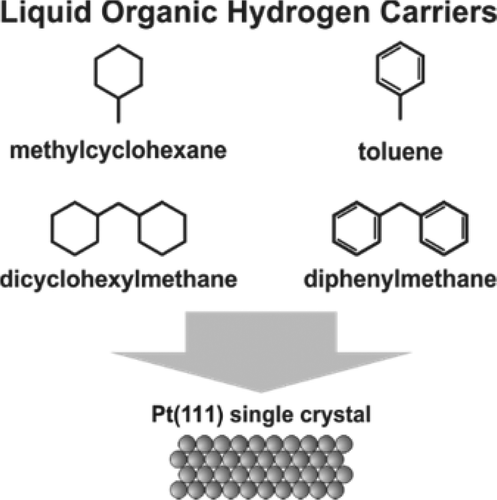当前位置:
X-MOL 学术
›
J. Phys. Chem. C
›
论文详情
Our official English website, www.x-mol.net, welcomes your
feedback! (Note: you will need to create a separate account there.)
Surface Reactions of Dicyclohexylmethane on Pt(111)
The Journal of Physical Chemistry C ( IF 3.3 ) Pub Date : 2015-08-19 00:00:00 , DOI: 10.1021/acs.jpcc.5b06178 Christoph Gleichweit 1 , Max Amende 1 , Oliver Höfert 1 , Tao Xu 1 , Florian Späth 1 , Nicole Brückner 2 , Peter Wasserscheid 2, 3, 4 , Jörg Libuda 1, 3 , Hans-Peter Steinrück 1, 3 , Christian Papp 1
The Journal of Physical Chemistry C ( IF 3.3 ) Pub Date : 2015-08-19 00:00:00 , DOI: 10.1021/acs.jpcc.5b06178 Christoph Gleichweit 1 , Max Amende 1 , Oliver Höfert 1 , Tao Xu 1 , Florian Späth 1 , Nicole Brückner 2 , Peter Wasserscheid 2, 3, 4 , Jörg Libuda 1, 3 , Hans-Peter Steinrück 1, 3 , Christian Papp 1
Affiliation

|
We investigated the surface reaction of the liquid organic hydrogen carrier dicyclohexylmethane (DCHM) on Pt(111) in ultrahigh vacuum by high-resolution X-ray photoelectron spectroscopy, temperature-programmed desorption, near-edge X-ray absorption fine structure, and infrared reflection–absorption spectroscopy. Additionally, the hydrogen-lean molecule diphenylmethane and the relevant molecular fragments of DCHM, methylcyclohexane, and toluene were studied to elucidate the reaction steps of DCHM. We find dehydrogenation of DCHM in the range of 200–260 K, to form a double-sided π-allylic species coadsorbed with hydrogen. Subsequently, ∼30% of the molecules desorb, and for ∼70%, one of the π-allyls reacts to a phenyl group between 260 and 330 K, accompanied by associative hydrogen desorption. Above 360 K, the second π-allylic species is dehydrogenated to a phenyl ring. This is accompanied by C–H bond scission at the methylene group, which is an unwanted decomposition step in the hydrogen storage cycle, as it alters the original hydrogen carrier DCHM. Above 450 K, we find further decomposition steps which we assign to C–H abstraction at the phenyl rings.
中文翻译:

二环己基甲烷在Pt(111)上的表面反应
我们通过高分辨率X射线光电子能谱,程序升温解吸,近边缘X射线吸收精细结构和红外光谱研究了液态有机氢载体二环己基甲烷(DCHM)在超高真空下在Pt(111)上的表面反应反射吸收光谱法。此外,研究了贫氢分子二苯甲烷和DCHM,甲基环己烷和甲苯的相关分子片段,以阐明DCHM的反应步骤。我们发现DCHM在200–260 K的范围内脱氢,形成与氢共吸附的双面π-烯丙基物质。随后,约30%的分子解吸,而约70%的π-烯丙基之一与260至330 K之间的苯基反应,伴随缔合氢解吸。在360 K以上,第二种π-烯丙基物质被脱氢成苯环。这伴随着在亚甲基处的CH键断裂,这是储氢循环中不希望的分解步骤,因为它改变了原始的氢载体DCHM。在450 K以上,我们发现了进一步的分解步骤,我们将其分配给苯环处的C–H。
更新日期:2015-08-19
中文翻译:

二环己基甲烷在Pt(111)上的表面反应
我们通过高分辨率X射线光电子能谱,程序升温解吸,近边缘X射线吸收精细结构和红外光谱研究了液态有机氢载体二环己基甲烷(DCHM)在超高真空下在Pt(111)上的表面反应反射吸收光谱法。此外,研究了贫氢分子二苯甲烷和DCHM,甲基环己烷和甲苯的相关分子片段,以阐明DCHM的反应步骤。我们发现DCHM在200–260 K的范围内脱氢,形成与氢共吸附的双面π-烯丙基物质。随后,约30%的分子解吸,而约70%的π-烯丙基之一与260至330 K之间的苯基反应,伴随缔合氢解吸。在360 K以上,第二种π-烯丙基物质被脱氢成苯环。这伴随着在亚甲基处的CH键断裂,这是储氢循环中不希望的分解步骤,因为它改变了原始的氢载体DCHM。在450 K以上,我们发现了进一步的分解步骤,我们将其分配给苯环处的C–H。





















































 京公网安备 11010802027423号
京公网安备 11010802027423号